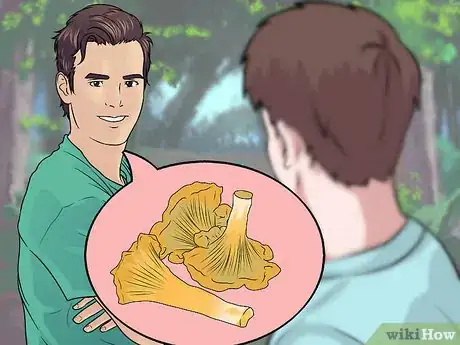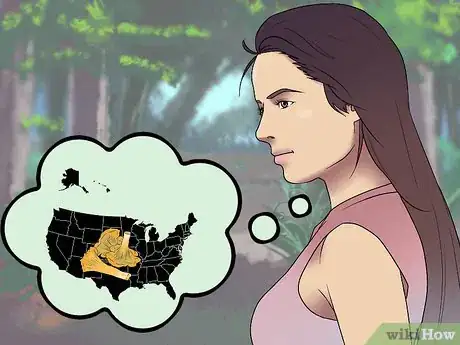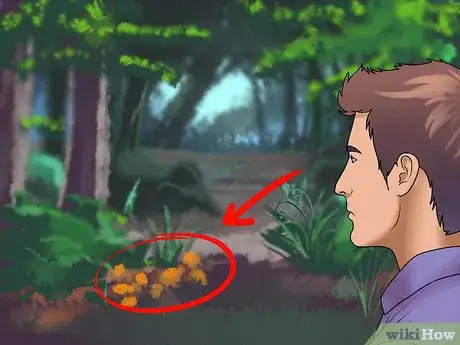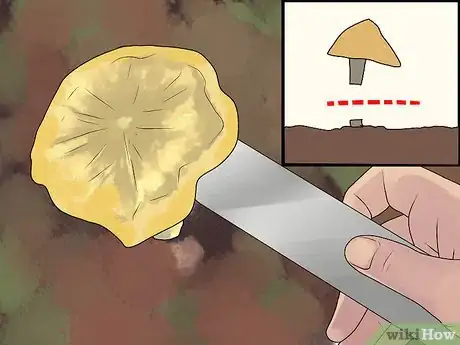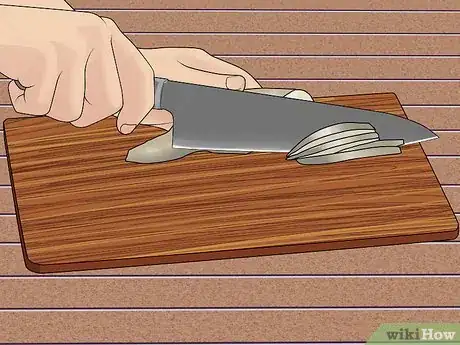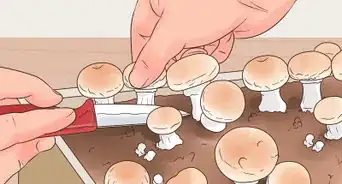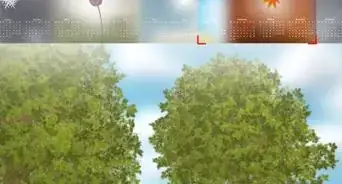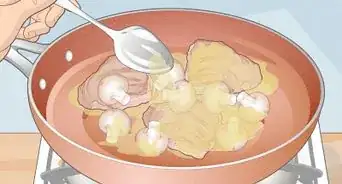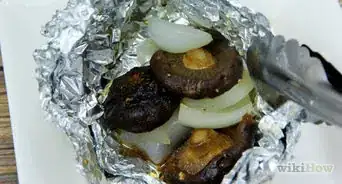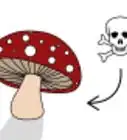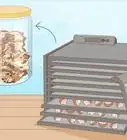This article was co-authored by Olivia Choong. Olivia Choong is a Plant and Gardening Specialist and the Owner of The Tender Gardener. With more than six years of experience, she specializes in gardening, permaculture, and self-sufficient and low-impact living practices. Her work has been featured in media outlets such as The Straits Times and Channel NewsAsia (CNA). Olivia holds a Bachelor of Mass Communications in PR and Journalism from Murdoch University.
There are 11 references cited in this article, which can be found at the bottom of the page.
This article has been viewed 316,258 times.
One of nature's finest delicacies can be found in your nearby woods or forest: the wild, edible mushroom. Many species of these fungi in the grocery store are costly and usually old. Picking your own is a fun way to get out into the great outdoors and experience the thrill of gathering your own food, and will also lend you fresh mushrooms!
Steps
-
1Find an experienced mushroom forager and ask to tag along on a foray. The best way to learn how to identify a mushroom is to go with someone knowledgeable and have them show you how to identify them. Many cities have a mycological society that you can join; sometimes they organize group forays.[1] If the society has a forum, use it. There's a much better chance of an experienced forager agreeing to teach you his or her ways if you:
- Offer to drive or pay for the gas.
- Promise never to visit the spots they show you, ever.
- Insist that you don't want to take any mushrooms home, you just want to learn and observe.
-
2Check if chanterelles grow in your area. The chanterelle grows in many parts of North America. The 'summer' species of the chanterelles are a deep yellow color and are in the shape of a trumpet when full-grown. This makes them quite easy to spot in the forest once you have stumbled upon an area conducive to their growth.
- The best seasons of the year to hunt the wild chanterelle are late summer and early fall, depending on the amount of rainfall the area has received. Mushrooms must have a good amount of rain in order to grow. So, if your hunting area has had a decent, wet summer, start your search in late August or early to mid September. If you go out and see small chanterelles peeking up from the moss, just give them a couple of weeks to mature, then return to the area to harvest.
Advertisement -
3Learn to identify trees, such as hemlock and Douglas fir. Chanterelles tend to grow from the roots of these trees. If the ground is grassy or if there is a lot of leaf litter (instead of pine needles), you will probably not find chanterelles in the vicinity.[2]
- Shown in this picture is a branch from a Douglas fir tree.
-
4Look carefully for slivers of orange peeking out from the ground. Can you spot the chanterelles in this picture? If you find one chanterelle, there are probably more nearby. Check the area surrounding the closest tree. Look at the ground from as many different angles as possible. Step carefully so you won't crush any chanterelles.[3]
-
5Cut the mushroom at the base. While experienced mushroom hunters may debate the merits of cutting versus pulling, most people cut. Set the harvested mushrooms in a mesh laundry or burlap bag, as this allows the spores to fall onto the forest floor.
-
6Verify your chanterelle's identity![4] The poisonous "look-alikes" most likely to cause problems are Jack-O'-Lantern mushrooms of the genus Omphalotus.[5] While these are easily distinguished from chanterelles by a sensible observer, carelessness can lead to a nasty set of digestive symptoms. In some locations, lethal Cortinarius species, which have true gills, may have similar orange coloration to the chanterelle. This can lead to dangerous confusion when someone attempts to identify a mushroom based solely on photographs.[6]
- Chanterelles have deep wrinkles or ridges underneath their caps, but do not have plate-like gills. Omphalotus species have true gills. Note the ridges in this picture. They are thick and not clearly separated. The ridges combine and split, unlike in gills.[7]
- Chanterelles grow in soil. Omphalotus species grow on decaying wood - but the wood may be buried and almost entirely decayed.[8]
- Omphalotus species may attain an olive tinge in age, but this is not to be relied upon.
- Other look-alikes include:
- The False Chanterelle Hygrophoropsis aurantiaca, which, like members of Omphalotus, has true gills. This mushroom may cause digestive upsets.[9]
- Gomphus floccosus is trumpet-shaped and ridged, like the chanterelle, but has a scaly, reddish-orange cap. Like Hygrophoropsis, it causes indigestion in some people.[10]
-
7Enjoy your harvest! Some say that all the preparation chanterelles need is a brushing to remove debris, while others will rinse them. If you rinse the mushrooms, leave them out to dry. When cooking chanterelles, many people get the best results by dry sautéing them to release excess water. The flavor of these mushrooms is light; don't put them in a very rich or savory dish.[11]
Community Q&A
-
QuestionI have found what must be 60 pounds of chanterelles on my property. I will of course not be picking more than a few pounds. Is there any way to save/freeze 4 or 5 pounds to have throughout the year?
 Community AnswerDry sauté the mushrooms, releasing all fluids. Pat dry with paper towel. Put in freezer bag and press out as much air as possible. Date and freeze.
Community AnswerDry sauté the mushrooms, releasing all fluids. Pat dry with paper towel. Put in freezer bag and press out as much air as possible. Date and freeze. -
QuestionHow can I find a chanterelle forager to teach myself and my sons about foraging for these delicious mushrooms?
 Community AnswerContact a mycological society in your area. Most of these societies or clubs can be joined for a small fee, which allows you to attend educational forays and learn from the experts in your area. There is a lot of information online, but nothing comes close to getting to know people who have foraged in your geographical region.
Community AnswerContact a mycological society in your area. Most of these societies or clubs can be joined for a small fee, which allows you to attend educational forays and learn from the experts in your area. There is a lot of information online, but nothing comes close to getting to know people who have foraged in your geographical region. -
QuestionWhen are the Chantrelles harvested?
 Janet ChepulisCommunity AnswerLate summer or early fall.
Janet ChepulisCommunity AnswerLate summer or early fall.
Warnings
- Be aware of local laws regulating mushroom collection. In some locations you can be hit with a hefty fine if you are caught with wild chanterelles and no permit to collect.⧼thumbs_response⧽
- Never eat a mushroom until you are 100 percent sure that it is edible. If you have any doubts whatsoever, discard!⧼thumbs_response⧽
Things You'll Need
- Basket or container to hold the mushrooms
- Good walking clothing (layers are best as the weather begins to cool) and suitable, comfortable shoes
- A friend – it's always more fun to mushroom hunt together
References
- ↑ https://namyco.org/clubs.php
- ↑ https://www.wildedible.com/foraging-chanterelles
- ↑ https://nature.mdc.mo.gov/discover-nature/field-guide/chanterelles
- ↑ https://www.youtube.com/watch?v=qLDOUSUW6fo
- ↑ http://bayareamushrooms.org/mushroommonth/jackolantern.html
- ↑ http://thescotsman.scotsman.com/features/Delicious-or-deadly-You-pick.4451032.jp
- ↑ http://mushroom-collecting.com/mushroomchanterelle.html
- ↑ https://blog.mycology.cornell.edu/2007/04/02/an-adventure-with-omphalotus/
- ↑ https://www.mushroomexpert.com/hygrophoropsis_aurantiaca.html
About This Article
To pick chanterelle mushrooms, wait until late summer or early fall since that's the best time of year to pick them. Then, when you go out searching, keep an eye out for hemlock and Douglas fir, which are both trees that chanterelles tend to grow out of. Also, look carefully for specks of orange, which is what the tops of chanterelle mushrooms look like. When you find one, cut the mushroom off at the base and store it in a mesh or burlap bag. To learn how to tell the difference between chanterelle mushrooms and other mushrooms that could be poisonous, scroll down!
